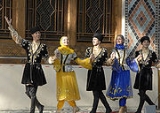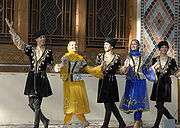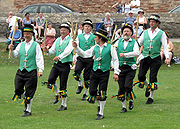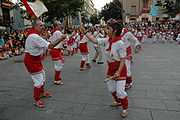
Folk dance
Encyclopedia


- They are dances performed at social functions by people with little or no professional training, often to traditional music or music based on traditional music.
- They are not designed for public performance or the stage, although traditional folkdances may be later arranged and set for stage performances.
- Their execution is dominated by an inherited tradition rather than by innovation (although like all folk traditions they do evolve)
- New dancers often learn informally by observing others and/or receiving help from others.
More controversially, some people define folk dancing as dancing for which there is no governing body or dancing for which there are no competitive or professional performances.
Terminology
The term "folk dance" is sometimes applied to dances of historical importance in European culture and history; typically originated before 20th century. For other cultures the terms "ethnic dance" or "traditional dance" are sometimes used, although the latter terms may encompass ceremonial danceCeremonial dance
Ceremonial dance is a major category or classification of dance forms or dance styles, where the purpose is ceremonial or ritualistic.This compares to other major dance categories based on purpose:* Celebration dance** Festival dance...
s.
There are a number of modern dances, such as hip hop dance, that evolve spontaneously, but the term "folk dance" is generally not applied to them, and the terms "street dance" or "vernacular dance" are used instead. The term "folk dance" is reserved for dances which are to a significant degree bound by tradition and originated in the times when the distinction existed between the
dances of "common folk" and the dances of the "high society".
A number of modern ballroom dances originated from folk ones.
The terms "ethnic" and "traditional" are used when it is required to emphasize the cultural roots of the dance. In this sense, nearly all folk dances are ethnic ones. If some dances, such as polka, cross ethnic boundaries and even cross the boundary between "folk" and "ballroom dance", ethnic differences are often considerable enough to mention, e.g., Czech polka vs. German polka.
Not all ethnic dances are folk dances; for example, ritual dances or dances of ritual origin are not considered to be folk dances. Ritual dances are usually called "Religious dances" because of their purpose.
Europe

- Polonez, Polish traditional dance,
- cloggingCloggingClogging is a type of folk dance with roots in traditional European dancing, early African-American dance, and traditional Cherokee dance in which the dancer's footwear is used musically by striking the heel, the toe, or both in unison against a floor or each other to create audible percussive...
, - English country danceEnglish Country DanceEnglish Country Dance is a form of folk dance. It is a social dance form, which has earliest documented instances in the late 16th century. Queen Elizabeth I of England is noted to have been entertained by "Country Dancing," although the relationship of the dances she saw to the surviving dances of...
, - international folk danceInternational folk danceInternational folk dance is a genre of dance wherein selected folk dances from multiple ethnic groups are done by the same dancers, typically as part of a regular recreational dance club, for performances or at other events. The dances are typically considered the products of national or cultural...
, - Irish danceIrish danceIrish dancing or Irish dance is a group of traditional dance forms originating in Ireland which can broadly be divided into social dance and performance dances. Irish social dances can be divided further into céilí and set dancing...
, - Maypole danceMaypole danceMaypole dancing is a form of folk dance from western Europe, especially England, Basque Country, Sweden, Galicia, Portugal and Germany,- History :...
, - Morris danceMorris danceMorris dance is a form of English folk dance usually accompanied by music. It is based on rhythmic stepping and the execution of choreographed figures by a group of dancers. Implements such as sticks, swords, handkerchiefs and bells may also be wielded by the dancers...
, - Welsh Morris DanceNantgarw traditionNantgarw tradition is a style of Morris dancing from the South and Valleys regions of Wales, specifically the small village of Nantgarw. The style encompasses both handkerchief and stick dances. The dances call for eight dancers in four pairs...
, - Nordic polskaPolska (dance)The polska is a family of music and dance forms shared by the Nordic countries: called polsk in Denmark, polska in Sweden and Finland and by several names in Norway in different regions and/or for different variants - including pols, rundom, springleik, and springar...
dance, - Ball de bastonsBall de bastonsBall de bastons is the name of a ritual weapon dance spread throughout Europe and the rest of the Iberian area . English and Welsh Morris dances are well-known relatives to these traditions. Most melodies are based on easy 2/4 rhythms...
, - square danceSquare danceSquare dance is a folk dance with four couples arranged in a square, with one couple on each side, beginning with Couple 1 facing away from the music and going counter-clockwise until getting to Couple 4. Couples 1 and 3 are known as the head couples, while Couples 2 and 4 are the side couples...
, and - sword danceSword danceSword dances are recorded from throughout world history. There are various traditions of solo and mock battle sword dances from Greece, the Middle East, Pakistan, India, China, Korea, England, Scotland and Japan...
.
Sword dances include Longsword dances and rapper dancing. Some choreographed dances such as contra dance
Contra dance
Contra dance refers to several partnered folk dance styles in which couples dance in two facing lines...
, Scottish country dance
Scottish country dance
A Scottish country dance is a form of social dance involving groups of mixed couples of dancers tracing progressive patterns according to a predetermined choreography...
, and modern Western square dance, are called folk dances, though this is not true in the strictest sense. Country dance overlaps with contemporary folk dance and ballroom dance. Most country dances and ballroom dances originated from folk dances, with gradual refinement over the years.
People familiar with folk dancing can often determine what country a dance is from even if they have not seen that particular dance before. Some countries' dances have features that are unique to that country, although neighboring countries sometimes have similar features. For example, the German
Germany
Germany , officially the Federal Republic of Germany , is a federal parliamentary republic in Europe. The country consists of 16 states while the capital and largest city is Berlin. Germany covers an area of 357,021 km2 and has a largely temperate seasonal climate...
and Austria
Austria
Austria , officially the Republic of Austria , is a landlocked country of roughly 8.4 million people in Central Europe. It is bordered by the Czech Republic and Germany to the north, Slovakia and Hungary to the east, Slovenia and Italy to the south, and Switzerland and Liechtenstein to the...
n schuhplattling dance
Schuhplattler
The Schuhplattler is a traditional Austro-Bavarian folk dance evolved from the Ländler.-Origins:The origins of this social dance are found in an early courtship display...
consists of slapping the body and shoes in a fixed pattern, a feature that few other countries' dances have. Folk dances sometimes evolved long before current political boundaries, so that certain dances are shared by several countries. For example, some Serbian, Bulgarian, and Croatian dances share the same or similar dances, and sometimes even use the same name and music for those dances.
Although folk dancing was historically done by the common people of the local culture, international folk dance
International folk dance
International folk dance is a genre of dance wherein selected folk dances from multiple ethnic groups are done by the same dancers, typically as part of a regular recreational dance club, for performances or at other events. The dances are typically considered the products of national or cultural...
has received some popularity on college campuses and community centers within the United States
United States
The United States of America is a federal constitutional republic comprising fifty states and a federal district...
and other countries
Asia
- AttanAttanAttan is a form of dance that originated in the Pashtun regions of Afghanistan, the Federally Administered Tribal Areas, Khyber Pukhtunkhwa and north Balochistan. Attan began as a folk dance conducted by Afghans in the time of war or during wedding or other celebrations...
- The national dance of Afghanistan - Azerbaijani dances
- Kurdish danceKurdish danceKurdish dance is a group of traditional hand-holding dances similar to those from the Balkans, Lebanon and Eastern European countries. It is a form of round dancing, with a single or a couple of figure dancers often added to the geometrical centre of the dancing circle...
- Assyrian folk danceAssyrian folk danceAssyrian Folk Dances are dances that are performed throughout the world by Assyrians, mostly on occasions such as weddings.-Types of Dances:...
- Georgian Folk Dances
- Bhangra a Punjabi harvest dance and music style that has become popular worldwide.
- GhoomarGhoomarGhoomar is a traditional women's folk dance of Rajasthan, India which was developed by the Bhil tribe and was adopted by other Rajasthani communities...
a traditional Bhil tribe women's folk dance of RajasthanRajasthanRājasthān the land of Rajasthanis, , is the largest state of the Republic of India by area. It is located in the northwest of India. It encompasses most of the area of the large, inhospitable Great Indian Desert , which has an edge paralleling the Sutlej-Indus river valley along its border with...
, India. - Ghumura DanceGhumura DanceGhumura Folk Dance[ , Kalahandia : ଘୁମ୍ରା ନାଚ୍ ] has earned both national and international name and fame in past three decades, after winning heart of Oriya people throughout Orissa. Its popular music is considered as one of those ancient folk musics, which after struggling a lot with the current...
: War Dance from Kingdom of KalahandiKalahandiKalahandi, , is a district of Orissa in India. The region had a glorious past and great civilization in ancient time. Archaeological evidence of stone age and Iron Age human settlement has been recovered from the region. Asurgarh offered an advanced, well civilized, cultured and urban human...
, OrissaOrissaOrissa , officially Odisha since Nov 2011, is a state of India, located on the east coast of India, by the Bay of Bengal. It is the modern name of the ancient nation of Kalinga, which was invaded by the Maurya Emperor Ashoka in 261 BC. The modern state of Orissa was established on 1 April...
, IndiaIndiaIndia , officially the Republic of India , is a country in South Asia. It is the seventh-largest country by geographical area, the second-most populous country with over 1.2 billion people, and the most populous democracy in the world... - KalbeliaKalbeliaKalbelia is one of the most sensuous dance forms of Rajasthan, performed by a tribe of the same name.-Kalbelia Tribe:The Kalbelias were known for their frequent movement from one place to another in ancient times. Their main occupation is catching snakes and trading snake venom. Hence, the dance...
is one of the most sensuous dance forms of RajasthanRajasthanRājasthān the land of Rajasthanis, , is the largest state of the Republic of India by area. It is located in the northwest of India. It encompasses most of the area of the large, inhospitable Great Indian Desert , which has an edge paralleling the Sutlej-Indus river valley along its border with...
, performed by the kalbelia tribe. - Israeli folk danceIsraeli folk dancingIsraeli folk dancing is a form of dance usually performed to music from Israel, with dances choreographed for specific songs. Most Israeli dances are performed in a circle, although there are also partner dances and line dances.-History and description:...
See also
- List of ethnic, regional, and folk dances sorted by origin
- Dance basic topics, a list of general dance topics
- BalfolkBalfolkBal Folk is a dance event for folk dance and folk music in a number of European countries, mainly in France, Belgium, the Netherlands and Germany. It is also known as folk bal.-History:Dancing to folk music is gaining popularity since the 70's...
, contemporary folk dance practiced across Europe
External links
- Folklore People Community
- About Folk Dances, Steps, Videos, Pictures
- Folk festivals around the world
- Society for International Folk Dancing, a UK charity that promotes international folk dance and whose associated groups run classes and events.
- Collection of folk dance videos
- Georgian Folk Dance Lessons

